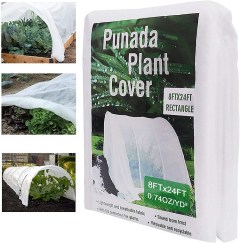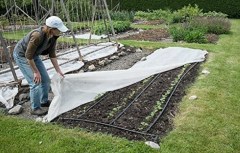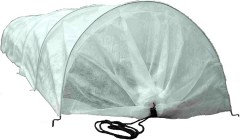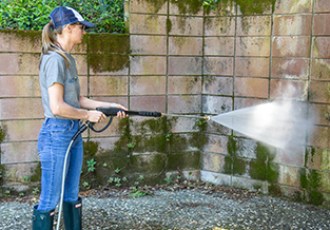BestReviews is reader-supported and may earn an affiliate commission. Details

Consider this option if you need an effective cover and protection from most weather and pest threats.
Consider this option if you need an effective cover and protection from most weather and pest threats.
Decent price for a large cover. Fairly lightweight and easy to use. Protects against weather conditions, including hail. Works well for covering raised gardens.
May not protect against major freezes. Polypropylene material is prone to tears. No framework included–just material.

An excellent model that protects against a variety of hazards without costing a lot of money.
An excellent model that protects against a variety of hazards without costing a lot of money.
Covers a large area yet comes at an affordable price. Protects from frost, UV damage, and insects. Promotes germination as it maintains moisture and warmth. Can be reused.
Material is somewhat thin and may not protect against severe weather or frost.

You may like this option if you're looking for short-term protection.
You may like this option if you're looking for short-term protection.
A lightweight cover made from double-bonded polypropylene material. Protects small, delicate seedlings without weighing them down. Suitable for light frosts.
Prone to ripping with typical use. Not likely to stay in place in windy conditions. May not last more than one season. No framework.

One of the best options for protection from insects and mild weather.
One of the best options for protection from insects and mild weather.
Patented design includes steel hoops. Ideal for pest protection throughout growing season. Fleece material is lightweight and allows moisture to flow through.
Flimsy material. Doesn't hold up well in heavy rain or wind. Not ideal for harsh frosts.

This floating row cover not only protects from cold weather and frost but is also a 100% organic solution to keeping pests and insects away.
This floating row cover not only protects from cold weather and frost but is also a 100% organic solution to keeping pests and insects away.
Cover is made with a lightweight and breathable polypropylene fabric. Allows sunlight to reach plants while still protecting them from frost damage.
Some users found the material to be very thin and prone to snagging and ripping, resulting in a short lifespan.

We recommend these products based on an intensive research process that's designed to cut through the noise and find the top products in this space. Guided by experts, we spend hours looking into the factors that matter, to bring you these selections.

Anyone who’s gardened for long knows that an “average” growing season is a myth. Late spring cold snaps, early frosts, and drought can cut your growing season short. A shorter growing season means a smaller, bland-tasting harvest and a lot of wasted effort.
Plant covers can help you get the most out of your garden, even when Mother Nature doesn’t cooperate. They trap warmer air around the plants to keep low temperatures from damaging your plants and your produce. Some help lock in humidity, and a number of them protect against pest damage, too.
Do you only need your plants covered a few nights when the temperature dips? Will your tomatoes and peppers need longer to ripen? Or would a semipermanent cover work better for your space and climate?

Are you looking for a temporary covering to place on top of your plants on cold nights? If so, you might want a frost blanket. If you have longer-term needs, a row cover may be a better solution.
Frost blanket: A frost blanket is a flat covering that you lay on top of plants to capture warm air underneath when temperatures drop too low for the health of your plants. To be most effective, the blanket must be placed on the ground just before dark so that it can trap daytime heat. Frost blankets must be removed in the morning to allow the sun to warm the ground and to avoid damaging the leaves.
Row cover: Also known as a floating row cover, this offers a longer-term solution for protecting your plants. Row covers feature metal frames or wooden stakes over which you drape the cover itself, so it’s held in place without touching the plants. You can use row covers like frost blankets — putting them on in the evening and taking them off in the morning — or you can leave them on for longer durations since both rainwater and some sunlight can pass through these breathable covers. They’re effective at keeping many kinds of insects and other garden pests off your plants, too. Taller, tunnel-style row covers may also help protect your plants from hail damage if violent weather is common in your area.
You’ll also need to think about how low the mercury usually drops. Are you looking for a cover that protects from a light frost, which can happen when the air temperature dips under 36°F? Heavy-duty covers that can withstand a hard freeze are meant to protect against air temperatures of 25°F to 28°F. Thinner plant covers boost temperatures underneath by 5°F or less, compared to the outside air temperature. Thicker covers may increase the temperature by as much as 10°F. Check on the hardiness of your specific plant. A number of plants can make it through a frost, but a hard freeze of 25°F will wreak havoc on most.
Most plant covers are made from either plastic or polypropylene.
Plastic: These plant covers are less expensive and are an acceptable choice for overnight use in a smaller garden. Plastic covers don’t breathe, so they may trap moisture underneath that can damage plants in freezing temperatures. And they provide little insulation in spots where the plastic contacts the leaves. They do, however, keep harmful icy water off your plants if you install the covers before the rain starts. Plastic covers can be combined with polypropylene covers to protect against moisture overnight. If you choose plastic covers, make sure you remove them in the morning when the mercury starts rising, so the plants can breathe again.
Polypropylene: These covers are much more breathable than plastic. This material can come as an insulating fleece, protective mesh, shady net, or sheet that holds in warmth and moisture. Polypropylene covers also let some light pass through to your plants, so photosynthesis can continue. You can spread polypropylene covers directly on the soil, over your plants, or wind them around a frame.
Note that plant covers can get caught on thicker, woodier stems and rip. Polypropylene covers may be fixed by stitching or patching. Torn plastic covers are usually not repairable.
More durable row covers come in various thicknesses. When choosing your covers, you’ll need to decide whether warmth or sunlight is a higher priority. Thickness can be listed in microns, ounces per square yard, or grams per square meter. All covers allow water from rain or irrigation sprinklers to pass through. Heavier covers protect better against cold, but let as little as 50% of sunlight through. Thinner row covers allow up to 95% of sunlight through, but they don’t insulate nearly as well. Also, thinner covers are easier to store than larger, thicker covers.
It’s important to choose a plant cover that’s the right size for your garden. Combining multiple pieces gives more opportunity for your cover to blow open, allowing warm air to escape. Choose a cover that’s long enough to cover your plants and lie flat on the ground around the edges. The top of the cover should touch as few leaves as possible, especially if you choose a plastic cover. If you choose a row cover with a frame, make sure the cover encloses the frame completely while lying flat on the ground. There are also some covers sized for shrubs and small trees.

A number of features help keep your plant covers in place and in good condition to give your garden the best chance to beat chilly temperatures.
Plant covers only work if they stay shut. Sheets can blow out from under stones, sandbags, and stakes, but drawstring ends make it easier to keep your cover shut, keeping warm air exactly where you want it. They also make the cover easier to open and expose the plants for pollination, weeding, fertilization, and other tasks.
Sunlight is essential for plants, but it isn’t so great for plant covers. The sun’s ultraviolet rays can break down plant covers, shortening their lifespan. If your covers will be outside during daylight hours, look for materials that have been stabilized to resist damage from UV rays. This should help you get multiple seasons out of your plant covers.
Moisture is another necessity that helps your plants but can damage your plant cover frame. Rainwater can crack wood and rust metal that hasn’t been properly treated. If you choose a framed cover, look for models with a galvanized steel frame that won’t rust or deteriorate in the rain.
Also, an accordion-style metal frame may be easier to fold and store than a square frame.

Prices for plant covers vary by size, material, and thickness.
Inexpensive: You can find budget-friendly sheets of plastic or thin polypropylene plant covers for $8 to $15. Plant covers in this price range will cover an individual garden bed or shrub and don’t come with a frame or stakes. They generally provide 5°F or less of insulation.
Mid-range: The next tier of plant covers costs $15 to $25. Some products in this price range come with a metal frame; others rest flat on the ground. All should be made from polypropylene mesh, netting, or thin fleece and provide 4°F to 8°F of insulation.
Expensive: The most expensive plant covers cost $26 to $30. In this tier, plant covers should be made from polypropylene fleece and come with a galvanized steel, accordion-style frame. If you’re paying this much, you should get up to 10°F of frost protection. They should have added features like drawstrings that make them easy to open and close to access your plants.

Don’t see what you need in our matrix? We found a couple of other products for you.
If you’re gardening on a budget, you’ll want to check the Easy Gardener Plant Protection Blanket. This fabric cover protects a patch measuring 10 feet by 12 feet, insulating it 6°F to 8°F warmer than the air temperature.
If you’re covering a larger space, consider the Punada Premium Plant Cover. This breathable cover can protect a whopping 24-foot-long garden bed from light frost.

Q. How do I use a plant cover?
A. Try to have your cover over your plants before the sun sets. This traps as much warm air as possible. Give the plants a light, gentle watering before covering if time permits. If you choose a framed row cover, make sure the ends are closed to conserve warm air. Unframed sheets should fit loosely over plants but be secured to the ground without gaps. Keep the cover on until mid-morning if possible. Temperatures reach their coldest just before dawn.
Q. Which plants do I need to cover?
A. Sometimes, produce like peppers, tomatoes, and watermelons need a few more weeks to fully ripen, especially if they got a late start due to a cold spring. But plant covers aren’t just for edibles. They can also help delicate decorative flowers like begonias and impatiens last a bit longer in your landscaping. They can even protect shrubs and bushes during unusually cold weather. Check for your specific plant type and hardiness zone.
Q. How do I use a plant cover in spring?
A. Plant covers can be used during a spring cold snap to protect seedlings or small plants that have been transplanted outside from indoors. These young plants are especially vulnerable to cold since they haven’t dealt with fluctuating temperatures before. Check your seed packet to see what temperatures your plants can handle, but remember that many seedlings start to suffer when temperatures drop under 50°F to 65°F. When in doubt, cover your seedlings. It’s better than losing all your hard work.
Get emails you’ll love.
Learn about the products you’re wondering if you should buy and get advice on using your latest purchases.
